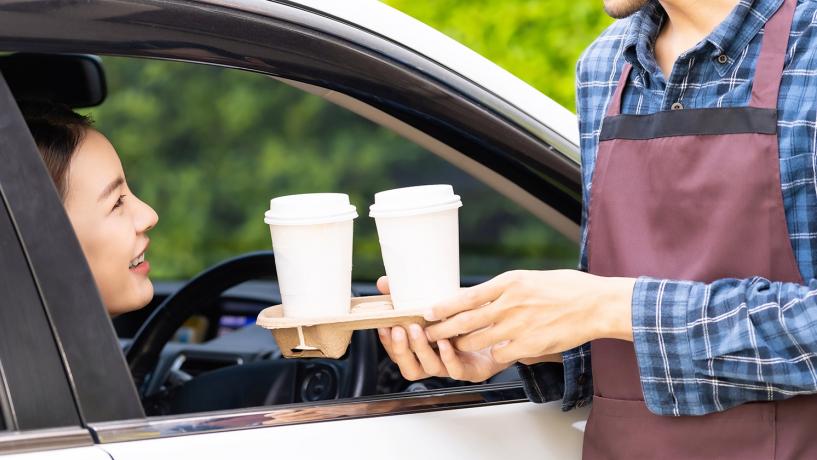
The COVID-19 pandemic has meant that Australian food businesses have had to get creative this year with how they serve their customers. Adopting take-away and delivery models has been the go-to for keeping the revenue coming in while indoor dining has been closed. For many food businesses, this has been the first time they have adopted these different business models.
For some food businesses, their drive-thrus have been extremely helpful with keeping their customers satisfied and the money coming in. Having a drive-thru continues to be a definite advantage, especially during the second wave of COVID-19.
But what about food businesses that do not have drive-thrus? Is adding a drive-thru to certain food businesses possible? It is important to know that adding a drive-thru to a food business doesn’t have to involve a drive-thru window. Food businesses can and should get creative with how to have a drive-thru, without the obstacle of installing a window.
If you do not already have a food business but are considering creating one, this is a helpful guide to get you started.
Check local laws and regulations
Before any official decisions are made, food businesses must follow up with their regional guidelines about what they can legally do. There may be laws and restrictions that hinder the ability to add a drive-thru service to the food business. It is always better to know what the laws are instead of making a costly mistake.
Step 1: Decide how to take orders
First, a food business needs to make a plan for how customers will order their food. There are a few options to consider such as:
- customers call in to place their order or order online through the business website
- customers place their orders by using a QR code on their phones when they arrive at the business location
- staff members bring out a tablet to the customer’s car and they place their order
These are just a few options to consider. No matter the ordering system that is used, it is important to ensure that it is affordable for the food business to implement. If it is too costly to implement a drive-thru system, then it is best to stick with the current business model.
Step 2: Organise the premises
Once an ordering system has been decided upon, it is essential to figure out where customers will wait to receive their orders. Will customers drive up to the front of the food business or will there be designated parking spots? There must be ample room on the premises as well as clear signage to instruct customers and indicate where waiting areas are in order to make sure this new service is effective and safe. These are the key things to consider when planning how the drive-thru will be operated.
Step 3: Decide on a delivery system
An important step in the planning process is deciding how customers will get their food. Depending on the layout of the business, customers can obtain their food in a variety of ways such as:
- customers call when they arrive and a staff member brings the food out to the customer’s car (this will involve the use of physical distancing measures as well as personal protective equipment)
- food is placed in a food locker for customers (this will involve customers calling the food business when they arrive and being told which locker to open and the passcode)
The benefit of the food locker option is that multiple meals can be waiting for customers at the same time. The cons to this option is that it's more expensive and food can get cold if waiting in the locker for too long, especially in the colder months. Also, passcodes to the lockers will need to be changed frequently. These are all things that need to be considered when deciding on how to deliver the food to customers.
Step 4: Make a payment plan
Deciding how customers will pay is also an essential part of the planning process. A simple way is to have customers pay for their meal over the phone or online, just like a take-away or delivery order. If that isn’t possible, staff members will need to bring out a portable payment terminal to the customers. In this case, PPE must be worn by the staff members and physical distancing must be maintained. Customers should also be encouraged to pay by Tap if possible, which reduces the touching of the terminal.
Step 5: Create the menu
Traditional drive-thru menus involve meals that can be made easily in order to serve as many customers as quickly as possible. Food businesses must decide which meals can be ordered through the drive-thru based on the ability to make them and how well they will transport. These meals will most likely be similar if not exactly the same to the ones provided for take-away and delivery.
Why are drive-thrus helpful during the pandemic?
While it may be significant work to adopt a drive-thru model, there are many benefits of drive-thrus for food businesses. Some of the benefits include:
- the convenience is attractive to customers
- the limited contact (which is very important during the COVID-19 pandemic)
- the ability for customers to support their favourite food businesses while staying safe
- the potential for an additional revenue stream
Lastly, adding a drive-thru can make a food business more adaptable for the changing times. With the recent COVID-19 pandemic, it is still unclear what the food industry will look like in the years to come. Having another revenue stream with a drive-thru can help food businesses better position themselves financially and operationally. Food businesses need to weigh the pros and cons of adding a drive-thru model to their operations in order to make the best decision for their situation — and then get creative.




